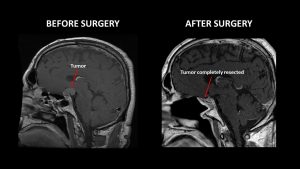Skull Base Tumors: What They Are and What to Do About Them
As ENT Skullbase surgeon Nikhil Jain, DNB, at Surana Group of Hospitals, Mumbai, explains, a skull base tumor can be life-threatening, but there are new options for treatment.

What are skull base tumors?
A skull base tumor is an abnormal growth in the part of the brain that meets the base of the skull. Most skull base tumors are benign (not cancerous) and don’t spread to other parts of the body. But even benign ones, which grow slowly, can cause serious damage.
What are the most common types?
- Pituitary adenomas are benign tumors that develop on the pituitary gland behind the eyes. These tumors can change levels in hormone production or cause vision loss.
- Vestibular schwannomas are benign tumors that develop on the nerve that connects the ear to the brain. They can cause hearing loss, ringing in the ear, loss of balance or facial numbness if untreated.
- Meningiomas are benign brain tumors that grow from the layers of tissue that protect the brain and spinal cord. These tumors are more common in men than women, and can grow very large before they produce symptoms.
What are the symptoms?
Symptoms depend on the size of the skull base tumor — how quickly it grows and what part of the brain it affects. Sometimes people don’t experience any symptoms and the tumor may be discovered incidentally. Often, though, a patient may experience a headache, vision or hearing loss, memory problems, weakness or numbness. Diagnosis begins with a neurological examination, followed by a CT scan or MRI scan of the brain. Specialized testing such as PET scanning or cerebral angiography may then be required. An image-guided biopsy (sample of the abnormal growth to see if it is cancerous) may be necessary for diagnosis.
What are the treatment options?
In the past, skull base tumor surgery was extremely difficult due to the complexity and risks involved. However, advances in technology over the past 30 years, as well as new minimally invasive surgical techniques, have made it possible to safely treat skull base tumors. In addition to surgery, some skull base tumors may be treated with medication, stereotactic radiation and chemotherapy. Sometimes, simple observation is the best treatment if the tumor is growing very slowly.

Why choose Surana Sethia & MPCT Hospital, Mumbai, for treatment?
Our Comprehensive Skull Base Surgery Center provides access to all of the coordinated expert care you need in one location, close to home —which can make the course of your treatment easier. Our team includes specialists in skull base tumors from every area — Otolaryngology (ear, nose and throat or ENT), neurosurgery, head and neck surgery, radiology, radiation oncology and anesthesiology. And we have successfully pioneered advanced skull base tumor removal techniques Viz. IMRT, IGRT that result in less discomfort and a quicker recovery time.
These include:
- Image-guided, minimally invasive endoscopic neurosurgery. There are no incisions with this sophisticated ENT technique. Instead, a thin, flexible endoscope is placed through the nose while a computer tracks the location of the endoscope and provides a more targeted view of the tumor. Instruments attached to the endoscope are then used to remove the tumor.
- Stereotactic (“knifeless”) radiosurgery. The use of advanced image-guided software to precisely locate a hard-to-reach skull base tumor allows our radiation oncologists to administer a small, highly targeted dose of radiation to slow the growth of the tumor, without affecting nearby healthy brain tissue.

